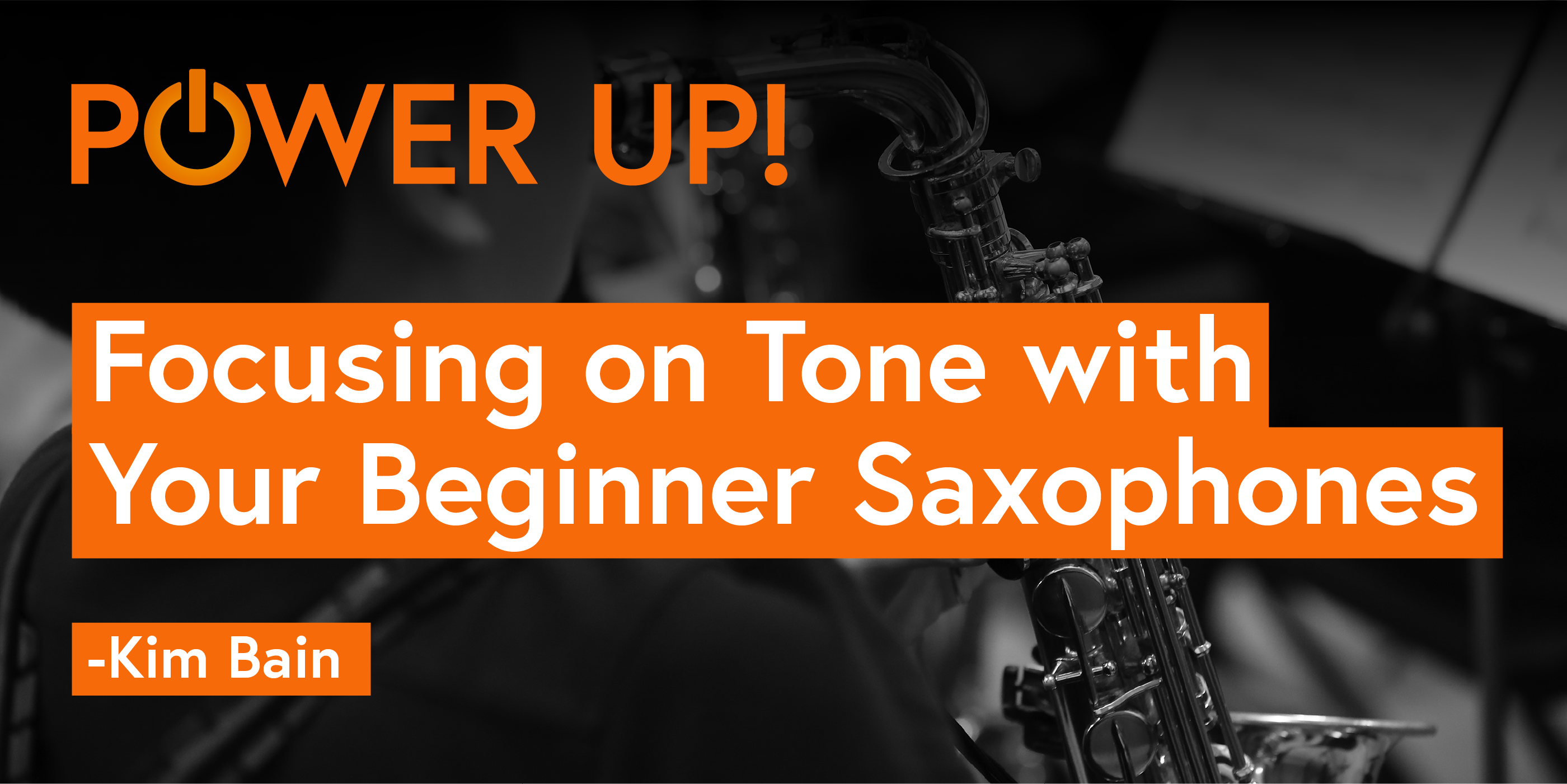
During my 34 years of teaching beginning saxophone, I always tried to teach our students the importance of playing with great tone from day one. During those first two weeks of school (prior to playing on instruments), we would listen to recordings of great players and create a word bank to describe the beautiful tone qualities. The next step would be to come up with antonyms of these positive words. Dark/bright, rich/thin, pure/spitty, etc. These critical listening exercises helped the students understand what a good saxophone tone should sound like; and just as importantly, what it should not sound like. Students need an understanding of this vocabulary prior to you coaching them towards a better tone.
The adage that the saxophone is the easiest instrument to play poorly is always on my mind at the start of the school year. As saxophone is my principal instrument, I try not to take offense to this outdated saying. Instead, I prefer to believe that the quote refers to how easily the saxophone can respond with certain mouthpiece and reed combinations. With the proper instruction, equipment, and encouragement, your beginning band saxophonists can reach their potential and be a positive for your program.
Mouthpiece Options
The saxophone is perfectly at home in both the classical and jazz worlds. Mouthpieces made for classical playing offer darker sounds, while mouthpieces for jazz tend to be louder and brighter. For our concert band needs, I do not recommend any mouthpiece that is made for jazz.
Of course, costs are ever rising for great saxophone equipment. If your school’s socio-demographic precludes students owning a good mouthpiece, consider having a school-owned set of good mouthpieces that are issued to the students. The Yamaha models listed below will work but the other models listed (especially the AL3) are the way to go if at all possible.
Recommended brands:
| Alto Saxophone | Tenor Saxophone |
| AL3 Vandoren | TL3 Vandoren |
| C Star Selmer | C Star Selmer |
| S90/190 S90/180 Selmer | S90/190 or S90/180 Selmer |
| Rousseau New Classic NC4 | Rousseau New Classic NC4 |
| Yamaha 4c | Yamaha 4c |
Reeds
Encourage your students to INVEST in great reeds. Make sure your saxophone parents understand this is an on-going expense PRIOR to them selecting saxophone as their child’s instrument.
My students started on a Vandoren AL3 Mouthpiece and Vandoren 2.5 Traditional (blue box) reed. Most students moved to a 3-strength reed early into the second semester. This set-up offered just the right amount of resistance and enabled them to start out making a great, characteristic sound. If your students start on a softer reed of inferior quality, it will be easier to produce a tone, but it will not be characteristic. If they start on harder reeds, many will produce thin or blasty tones because their young embouchures are not ready to handle the extra reed strength. After the students have spent time playing with thin or blasty tones, it will be much more difficult to teach them how to play with a more characteristic sound. Save yourself the headache and start with good reeds and mouthpieces from the beginning.
Reed Brands: Vandoren Blue Box Traditional Cut 2.5; Vandoren V21 2 or 2.5, D’Addario Reserve 2.5.
Embouchure
- The top teeth rest on the top of the mouthpiece, directly above where the reed first touches the side rails of the mouthpiece. (This spot can be located by placing an index card in between the reed and mouthpiece). Too much mouthpiece = blasty, honky sounds; too little=thin, non-resonant sounds.
- Roll a small portion of the lower lip over the bottom teeth. (Think putting on ChapStick in the winter) This creates a cushion that touches the reed. Do not roll too much lower lip in or the chin will bunch.
- The upper lip rests on the mouthpiece without curling under or being placed under the top teeth.
- Move the corners of the lips toward the mouthpiece to create a seal around it.
- Avoid pressure from the jaw with biting. Pressure should be horizontal towards the mouthpiece, not vertical from the teeth and chin.
When your students start making their first sounds, spend lots of time on the “tiny saxophone.” This is the mouthpiece, reed, ligature, and neck only. Play lots of “I play, then you play” games. Have the students echo you and focus on looking at your embouchure as you do this. The name of the game here is modeling. By not having the entire instrument to worry about, you will be better able to evaluate how their embouchures are developing.
It is also helpful to have the students use a mirror while doing this embouchure/tiny saxophone work. Seeing is believing.
Teach the students that occasionally they must “vacuum” the reed. When you hear spitty, gurgling sounds in the tone, it usually means that there is excess moisture on the back of the reed that must be cleared. Show the students how to quickly inhale to vacuum this off. Older, dead reeds sometimes hold more water and it is a sign that it is time for a new reed. Teach your students that good saxophone tone does not sound like someone is frying bacon!
Articulation
It is very difficult to separate embouchure work from articulation work. If you desire that your saxophone section play with great sounds, poor articulation skills can destroy a great saxophone tone in a heartbeat. Do not delay introducing articulation or students may not ever embrace it.
The shape of the oral cavity is important when prepping the students for articulation. Get students to close their eyes and really think about how the inside of their mouth, throat, and tongue feel. Ask them to silently form an “aw” syllable (allow lips to part) like they are yawning. Ask them if they feel how this lifts the middle of the tongue. Now that they are sensing their oral cavity you are ready to talk about articulation.
Things to remember:
- Move only the tip of the tongue, not the entire tongue.
- While many directors are still comfortable with using a “t” syllable for tonguing, this can cause a small blast of air at the front of the note, making the articulation sound too heavy. Try using a “dah” syllable to avoid this.
- Remind the students that the tongue interrupts the air rather than stopping the air. The air never stops.
- Start with the tongue against the reed and while blowing air, pull the tongue away from the reed to start the tone.
Horn Carriage/Posture
Awkward beginning band middle schoolers can really struggle with the neckstrap when first learning to assemble and play their instrument. I always required my students to pass the “neckstrap test” prior to moving on to making their first sounds. Be sure they can tighten and loosen the strap into the correct position so that the mouthpiece enters the embouchure slightly below the horizontal position. Whether your alto students play in the middle or to the side, you cannot form a good embouchure if the neckstrap is not adjusted to proper playing position.
Another posture concept that impacts breathing and tone is body alignment. Be sure that the students are sitting tall with “head, shoulders, knees, and toes” all in alignment. This will allow the mouthpiece to enter the embouchure correctly and free up the breathing apparatus for full inhalation and exhalation.
Exercises and Pieces for Beginning Saxophonists
Vogt Williams, Darcy and Balmages, Brian (2023). Count Me In. FJH.
These charts are the perfect way to learn how to count while you work tone production on your “tiny saxophone.”
Williams, Richard and King, Jeff. Foundations for Superior Performance. Kjos. 1997. Exercises 1a–1c and 2a–2c
After your students have learned the first 5 notes of concert B-flat scale you are ready for them to dive into the exercises in front of the book. Exercises 1a–1c and 2a–2c are perfect warm-ups when the students are ready.
Curd, Tim. 14 Easy Duets. Published by the composer.
It is so important for beginning saxophonists to get excited about solo and ensemble/chamber music. This set of very easy duets will motivate the students to practice while they learn these duets based on folksongs and patriotic music of Americana.
Ostling, Acton and Weber, Fred. Student Instrumental Course-Duets for Alto Saxophone Students Level 1. Alfred. 2000.
The Belwin Student Instrumental Course is for individual instruction and class instruction of like instruments. This collection of well-arranged beginning band classic melodies is perfect for growing your students’ interests in small group performance.
References:
- Teal, L. (1963). The Art of Saxophone Playing. Alfred Music.
- Richtmeyer, D. (2021). The Richtmeyer Method for Saxophone Mastery, Vol 1 (Vol. 1). Presser.
Best wishes to everyone as you impart the true potential of the saxophone with great teaching of fundamentals!
 Explore the NEW Sound Innovations Extras for concert band and strings in MakeMusic Cloud and you’ll find hundreds of excellent supplemental exercises that will reinforce the concepts you are teaching alongside exciting movie soundtrack accompaniments.
Explore the NEW Sound Innovations Extras for concert band and strings in MakeMusic Cloud and you’ll find hundreds of excellent supplemental exercises that will reinforce the concepts you are teaching alongside exciting movie soundtrack accompaniments.